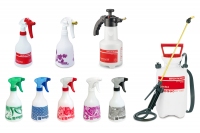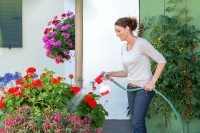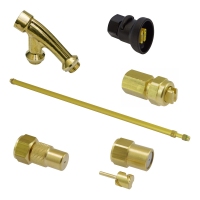Tips for spraying and spreading
General information for selecting the right sprayer

Using the right sprayer with the optimum equipment saves time and spraying agent. To make it easier for you to choose a sprayer, we have set up a product selector on our website www.birchmeier.com
Using various criteria, it helps you find exactly the right device.
When choosing a device, the following general rules apply:
- The larger your garden or the job, the larger the device.
- Hand sprayers are adequate for smaller jobs.
- If you need to apply several litres, pressurised sprayers with a filling volume of 1 to 5 litres are appropriate. Pressurised sprayers offer the advantage that they allow continuous spraying.
- For larger gardens with 20 or more rose bushes, hedges or trees, we recommend that you use a backpack sprayer. Products ranging from basic models such as the cutting-edge RPD with plug-in system to top-spec devices such as the Iris or Flox are available. Solid, robust and popular throughout the world, these backpack sprayers have offered excellent performance under the most difficult conditions for decades.
- The range is rounded off by rechargeable and motorised devices.
- Depending on your needs, you can also choose from a range of accessories tailored to your individual device.
Whether you are a demanding gardener, a private user or a professional, you are sure to find the right device in our range. Simple devices with plug-in systems and a maximum pressure of 3 bar are perfectly adequate for occasional use. For more frequent use, we recommend devices with screw fittings which allow a pressure of 4 bar or more. Hand sprayers can be used for smaller jobs. Small pressurised sprayers are more convenient when spraying amounts exceeding 0.5 litres or for multiple applications. They also allow you to spray more evenly and work faster. When spraying amounts exceeding approx. 2 litres, we recommend pressurised sprayers with a 3 or 5 litre filling capacity. Generally speaking, pressurised sprayers have an integrated air pump which builds up the pressure. Depending on their features, they can also be pressurised using compressed air from an external compressor. This means that there is no need to use the hand pump to build up the pressure. The higher pressure also means less pumping later on.
House plants

House plants grow particularly well if they are sprayed regularly with lukewarm water. Beautifully green and luxurious leaves can be obtained by spraying the plants with a diluted liquid fertiliser. Your dealer will be able to recommend a suitable fertiliser. An insecticide or miticide will help you get rid of any harmful insects, mealybugs and spider mites.
You should choose concentrates specially designed for application with a sprayer. This is more economical, cheaper and less harmful to the environment. Follow the instructions carefully to ensure the correct concentration! Repeat 3-4 times at intervals of 10 days.
Recommended sprayers:
Hand sprayers or small pressurised sprayers with a filling volume of 1-3 litres.
Roses

When the buds start forming in the spring until the end of September, it is important to check for pests and diseases every 14 days. In order to prevent fungal diseases such as powdery and downy mildew, rust or black spot, rose bushes should be sprayed thoroughly with a fungicide early on.
The last treatment should be carried out in late autumn in order to prevent the hibernation of harmful fungal spores. If your roses are attacked by fungi, cut off any wilted flowers promptly to prevent further spreading. Spray aphids as well as all plant-eating and sap-sucking insects immediately with an insecticide.
An acaricide is particularly effective against spider mites. The treatment should be repeated at intervals of no more than 14 days until all pests have been eliminated. Always dilute the concentrates used with the prescribed amount of water. Use up any remaining solution within 24 hours. After this time, the effectiveness will be reduced. Always follow the manufacturer's instructions!
Recommended sprayers:
Up to 10 rose bushes:
Small pressurised sprayers with a filling volume of 1 to 3 litres
Up to 20 rose bushes:
Pressurised sprayers with a filling volume of 5 litres
20 or more rose bushes:
Backpack sprayers with a hand pump.
Larger gardens or frequent use:
Rechargeable or motorised backpack or cart sprayers
If you have climbing roses, use a telescopic extension. For small-scale attacks in large gardens, we recommend a long-distance sprayer such as the Florajet.
Balcony plants such as geraniums, petunias, lantanas
Sheltered balconies are usually dry and warm, thereby providing an ideal climate for aphids, spider mites and whitefly. We therefore recommend that you check your plants carefully and use a suitable insecticide at the first sign of any pests. Concentrated insecticides designed to kill aphids and white flies are available from specialist shops. Spray the plants thoroughly, paying particular attention to the underside of the leaves.
It is important to spray your plants at least four times at intervals of 10-14 days. Spider mites cannot be treated with conventional insecticides. In this case, only special concentrates, e.g. acaricides, are effective. Once again, you must treat your plants a number of times.
Incidentally, seed production is the main priority of any summer flower. You should therefore cut off wilted flowers immediately. This will encourage the plant to produce even more flowers and prolong the flowering period.
Recommended sprayers:
Hand sprayers, Florajet, pressurised sprayers with a filling volume of 1-3 litres.
Fruit trees, berries, vines

Who wants to eat maggoty fruit? To prevent attacks, fruit trees need to be treated with suitable insecticides early on and at regular intervals thereafter. Early treatment is also required in order to control scab and mildew. To prevent monilia fruit rot from attacking apple trees, spray them with a suitable product when the buds begin to swell.
Treat your trees with a fungicide when they begin flowering and when the flowers start to wilt. The larvae of the raspberry beetle are unwelcome guests on raspberry bushes. Simply spray a suitable insecticide after the plants have reached full bloom. Although blackberries are very robust plants, they can be badly damaged by blackberry mites. When it comes to vines, espalier vines are particularly susceptible to scale insects. They rob the vine of valuable nutrients and secrete honey-like substances. This allows various sooty mould fungi to develop, blackening the grapes and the leaves. Spraying the plants with appropriate products in winter helps. Black vine weevil larvae and grubworms can cause considerable damage to the roots. A suitable spray agent or the use of useful organisms such as nematodes is recommended. Trained staff in specialist shops or advice services can provide further information. Depending on the job, the use of a gun product, e.g. the Vario Gun, or, for a pressure of more than 10 bar, the Gun Media, can make your work much easier. Depending on the particular device, these produce a mist or a jet which can travel up to 8 m.
Recommended sprayers:
Depending on the size of the trees: Pressurised sprayers with a filling volume of 3 litres or more. For larger gardens or trees: Backpack sprayers or cart sprayers. Telescopic pipes can save a great deal of time and spray solution and are available in lengths from 1 m to 7 m.
Eradicating weeds

Herbicide treatments are most effective if the agent is applied under "vigorous growing conditions". For the next 24 hours, ensure that the herbicide is not washed off by rain or watering. Unlike with a watering can, spraying ensures that fine droplets adhere to the weeds, thus making the herbicide more effective. Spraying also reduces the harmful effects on the soil.
Recommended sprayers:
The particular job determines the best device to use. For a lawn that has only a few weeds, spot-treating may take longer but will save a great deal of spray agent and reduce the impact on the environment. Small pressurised sprayers with a filling volume of 1-3 litres (or possibly 5 l) are adequate for this purpose. A larger lawn or garden can also be treated in this way. Depending on the job, we offer round or oval spray hoods with specially tailored nozzles. Spray hoods prevent drifting caused by the wind and thus help to protect neighbouring wanted plants. For treating large areas, we recommend backpack sprayers with spray booms or our special angled nozzle. The latter is easier to use than a spray boom and allows you to work very quickly. Herbicides should always be applied at a low pressure between 1.5 and 2 bar. This produces larger droplets and therefore reduces drifting. We recommend that you use our adjustable pressure control valve PR 3. This ensures a constant pressure and thus a constant droplet size and spray volume.
Vegetables, tomatoes, herbs etc.

Aphids, caterpillars etc. can be controlled with standard insecticides whose natural active ingredients are broken down by the plants after only a short time. After an appropriate waiting period, the vegetables can be eaten without hesitation. However, they should be washed thoroughly first. If you grow tomatoes, you should support the plants as soon as 8 fruits have formed. If your tomatoes show the first signs of leaf mould, use a suitable fungicide. Spider mites cannot be treated with conventional insecticides. In this case, only special concentrates, e.g. acaricides, are effective. Once again, you must treat your plants a number of times.
Recommended sprayers:

Depending on the number of plants, small pressurised sprayers,
backpack sprayers or cart sprayers with hoses up to 50 m in length.
A beautiful lawn
A lot of people would like to have a thick, green and even lawn with no weeds or bare patches etc.. However, this requires a great deal of work and know-how. Cutting the grass is the easy part. Often and not too short is the simple rule for normal lawns. Soil care, watering and mechanical treatments such as scarifying or aerating need to be carried out correctly. Numerous useful tips are available on the Internet.
We offer a number of useful devices here:
![]()
For weeds and moss: Numerous herbicides are available on the market. For herbicides that need to be sprayed, we offer spray booms with four nozzles specially designed for treating large areas. We also offer a manoeuvrable angled nozzle which is ideal if you need to work around many corners or bushes. However, it takes a bit of practice as you can quickly find yourself spraying in the wrong direction.

If you would prefer to spot-treat individual weeds, you can use our Super Star 1.25 / 360° with the small spray hood.

Watering agents or liquid fertilisers: Our Aquamix model is ideal for anyone who wants to treat their lawn with a liquid fertiliser or soil improvement product that is diluted with water and then watered in. You simply fill it with liquid fertiliser for example, connect it to a hosepipe and then apply the mixture to the lawn area. Precise mixing ratio selectable: 0.2%, 0.5%, 1.0% and 2.0%. Neutral position for watering without concentrate. With a mixing ratio of 0.2%, 1 litre of liquid fertiliser yields 500 litres of watering solution. This saves you having to carry heavy watering cans.
Recommended sprayers:
Depending on the size of the lawn and the frequency of treatment.
Granular fertilisers:

A variety of tools for applying granular fertilisers are available. Many of them are awkward to use. The results are often poor or even disastrous! Spreading by hand is then the only alternative. However, this can result in burnt or sparse patches where too much or too little fertiliser was applied.

Our newly developed, patented Granomax fertiliser spreader provides a simple yet effective solution. Granomax, the ideal spreader for fertilisers and de-icing agents. You simply fill the bag with fertiliser using a measuring cup or scoop, fasten the zip and hang the bag over your shoulder. You can now use your spreading hand to scatter the fertiliser over your lawn, under bushes, under roses or wherever it is needed. In winter, it is perfect for spreading salt or other de-icing agents too – quickly, easily and evenly. Why not try the Granomax for yourself?
You will love it!
Refuelling lawnmowers or other engine-powered tools.

You are sure to be familiar with the problem. Refuelling often ends in spilt petrol and smelly hands, burnt lawns or stains on your path. But not if you use Rapidon, the petrol can with a clever flow button. Simply pull out the spout and the valve button. Fill your tank at the push of a button, with no spillage. Job done!
Our specially developed, patented petrol can has won numerous innovation awards and other prizes. Why not give it a try? You will love it – just like many other people before you. We also offer funnels if you find that you need one when doing a job. The venting groove ensures an even flow without bubbling. During pouring, the lip on the edge of the funnel prevents the liquid overflowing on the opposite side. What is more, the fine brass mesh which acts as a sieve in the funnel filters out small particles or water droplets that may have formed in the fuel. This helps to prevent problems when the engine is running. A popular choice for decades, suitable for petrol and diesel.
The right nozzle

The nozzle that you use plays a key role too. Using the right nozzle saves spray solution, time and makes treatments more effective. Professionals who always use the same device for a specific job prefer fixed nozzles with a specific hole size. The constant spray characteristics and delivery rate allow them to spray more evenly. For universal use, however, we recommend adjustable nozzles. In this case, the spray characteristics (jet or mist, spraying angle) can be adjusted. It may also be possible to adjust the delivery rate. For large areas, we recommend fan nozzles, for bushes and hedges – full or hollow cone nozzles. Our range of nozzles and accessories such as multiple nozzle holders, extensions or telescopic tubes etc. offers a solution for (virtually) any job.
Concentration conversion table
 Open concentration conversion table
Open concentration conversion tableIt is important to use the right agent, the right device and the right equipment. However, the correct mixture and quantity for treating a specific area are just as important. Be sure to follow the manufacturer's instructions. Using a "little bit more" is simply a waste. It brings no benefits and will only harm the environment. With many agents, it is very important to wet the surface thoroughly. Tip: Adding a drop of washing-up liquid to the solution will reduce the surface tension of the water and improve wetting and adhesion. This can make the treatment more effective.
General tips
- In most cases, pesticides in the form of concentrates are considerably cheaper than ready-mixed products.
- Determine the exact cause of damage before selecting the appropriate agent. If in doubt, ask a member of staff from a specialist shop.
- Do not mix more solution than you need and dispose of any remaining solution in accordance with the manufacturer's instructions. Do not pour unused solution down a drain. Always follow the manufacturer's instructions for mixing and use!
- Using the right nozzle and pressure saves spray solution, time and makes treatments more effective. Select the right nozzle. If you use an adjustable nozzle, adjust it first using pure water and the intended pressure until you obtain the desired spray characteristics. Solutions (e.g. herbicides) which are applied with large droplets (for less drifting) should be sprayed at a low pressure between 1.5 and 2 bar. If a fine mist is required, use a higher pressure and adjust the nozzle accordingly.
- If possible, mix your solution in a bucket or other container rather than in the sprayer itself. If you do need to mix a solution in the sprayer, always add part of the water first! Only then should you add the amount of agent needed to produce the desired concentration, followed by the rest of the water. This ensures better mixing and prevents concentrate running into an opening in the device or the outlet hose which would alter the concentration of the solution.
- When mixing a solution, always wear rubber gloves and goggles.
- To avoid clogging the hose and nozzle, ensure that powders are completely dissolved before filling up the sprayer.
- Always clean the sprayer after use.
- A device which has been used to apply herbicides should only ever be used for herbicides. Even slight residues can harm wanted plants.
- In many cases, it is more important to treat the underside of the leaves. You should therefore point the nozzle so that the jet comes out in an upward direction.
- Clean and maintain your devices regularly. Check for damage or defects on a regular basis. Always replace damaged parts immediately. Do not expose devices to cold, heat, sun, wind and the weather unnecessarily. This can extend the life of the product considerably. If something should break, we keep spare parts. Depending on the product, these are available for up to 10 years after a product is discontinued.
Technical terms
| Fungicide: | Combats fungal diseases. |
| Insecticide: | Kills insects (6-legged). |
| Acaricide: | Kills mites (8-legged). |
| Herbicide: | Kills weeds. Selective herbicides target weeds only in a lawn. |
| Powdery mildew: | A white, floury coating which spreads, covering areas of an entire plant. |
| Downy mildew: | Only occurs on the underside of leaves. Small white grey to mouse grey blotches. Causes yellow blotching on the upper side of the leaves which changes to orangey or purplish red later on. Also causes significant loss of leaves in many cases.
|
Find the right Birchmeier sprayer for any job with the help of the product selector on our website.




 Country selection
Country selection



























 Open concentration conversion table
Open concentration conversion table